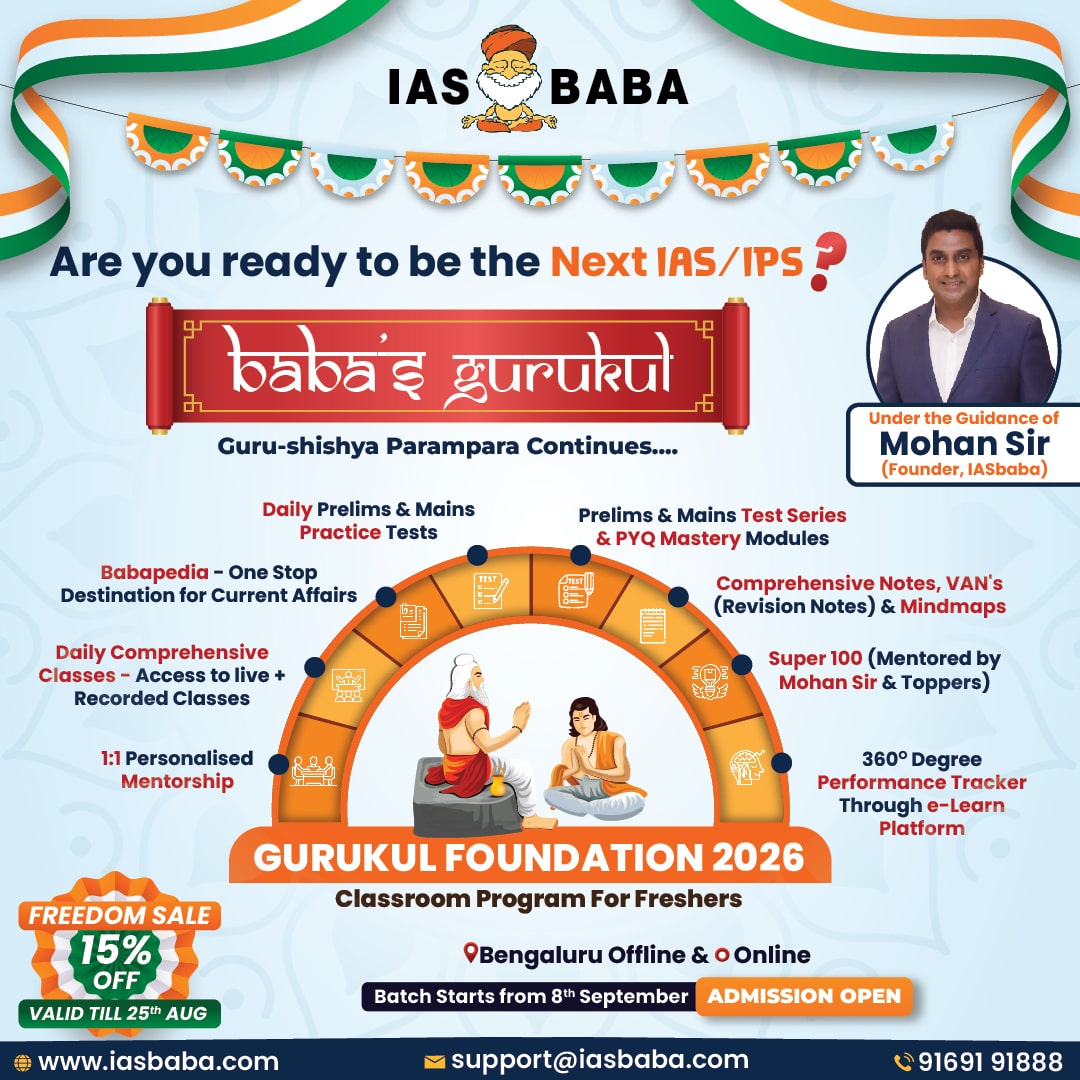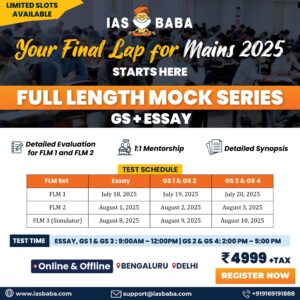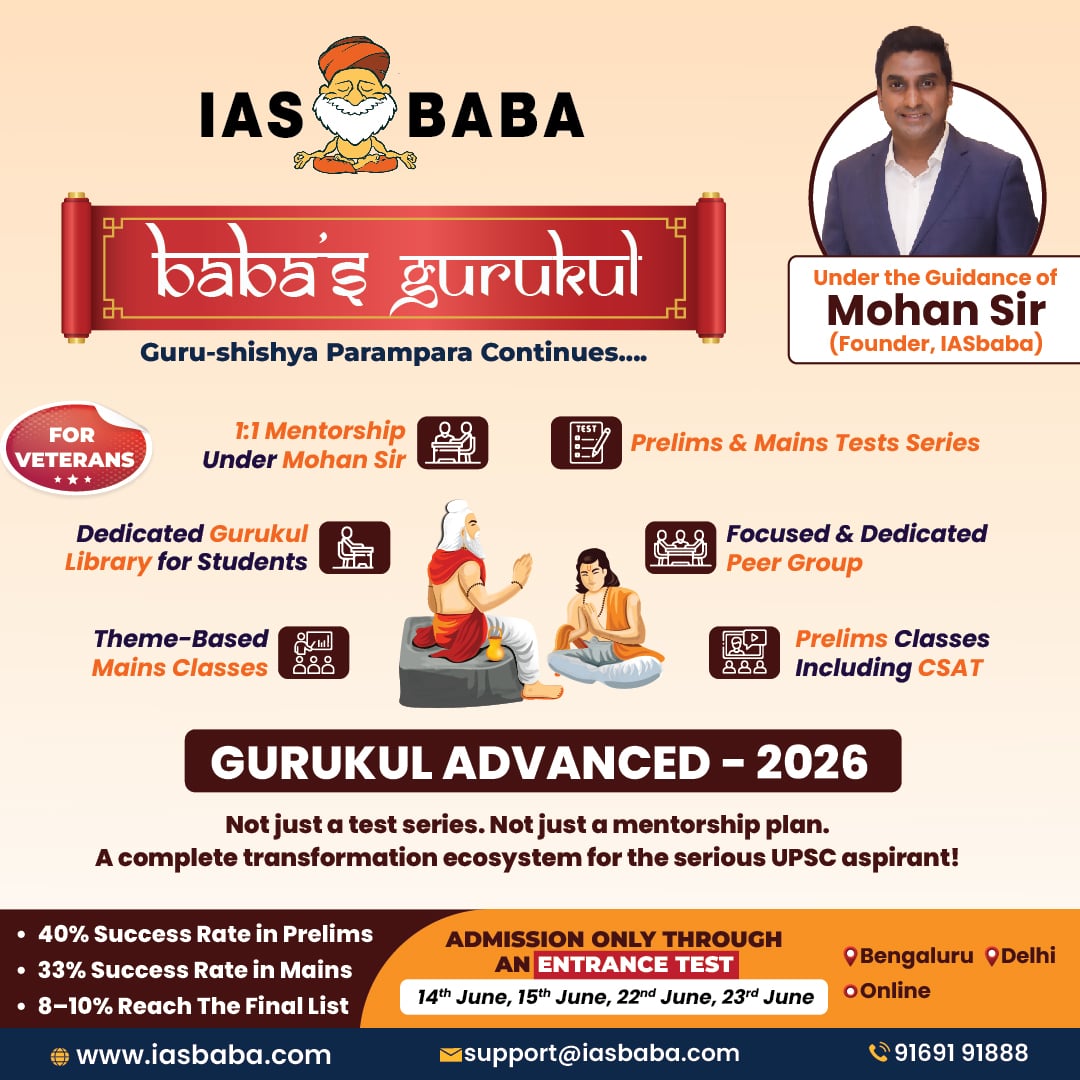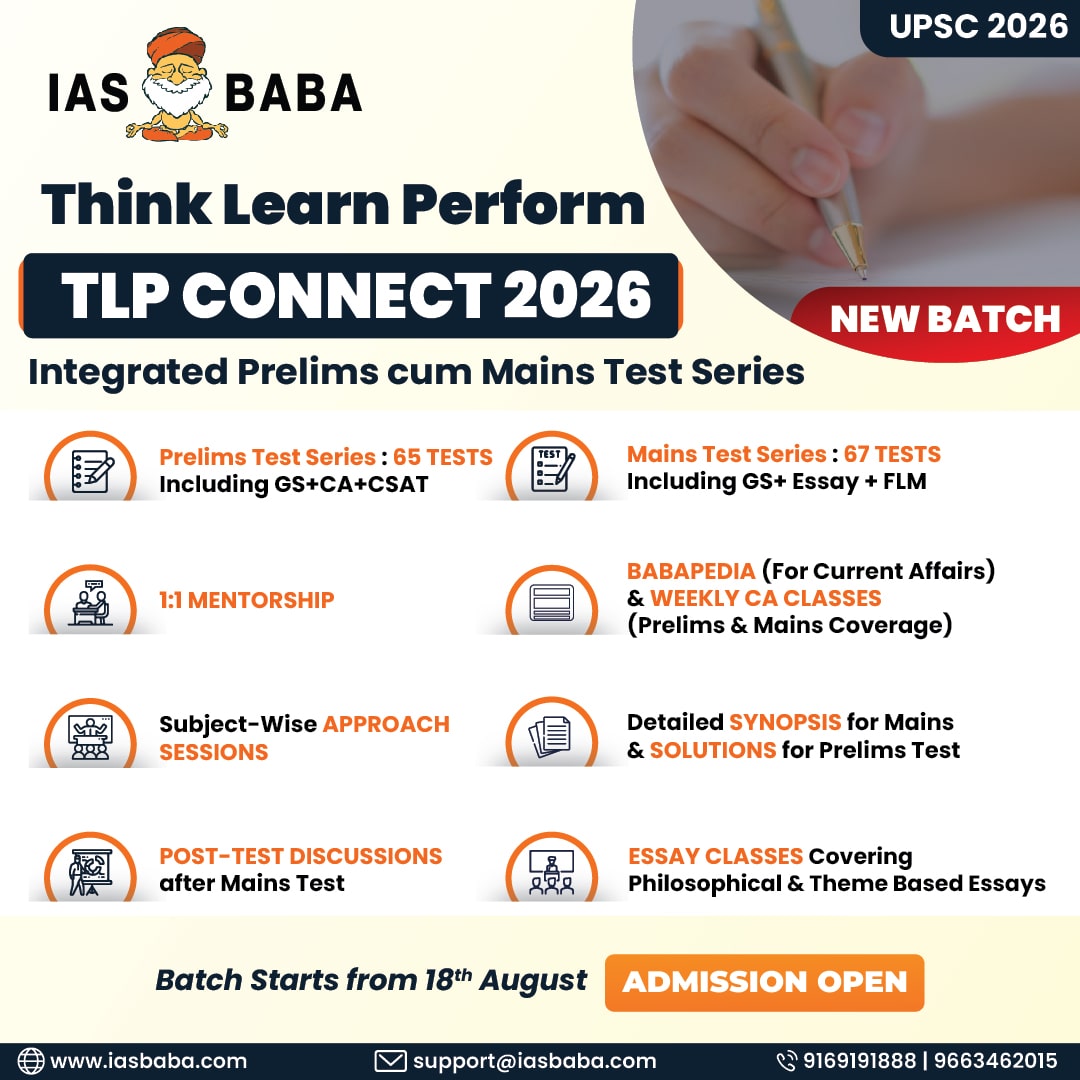IASbaba's Hot Questions, IASbaba's Think Learn Perform 2016, IASbaba's TLP - 2016, Think Learn Perform (TLP)- 2016, UPSC Mains Answer Writing - 2016, UPSC Mains Questions 2016
ARCHIVES
SYNOPSIS- IASbaba’s TLP 2016 [14th Sep] – UPSC Mains GS Questions [HOT]
1. The theme of Lord Buddha in meditation finds a prominent place in the rich visual art forms of India. Discuss.
Introduction:
Lord Buddha’s depiction of meditation is seen in various visual art forms, especially sculpture and painting. He is shown as sitting in “Padmasana”. This depiction of Buddha began with the advent of Mahayana Buddhism, earlier on images of things were worshipped
Meditating Buddha was common theme in many sculptures and paintings of ancient India
- Gandhara School of art, produced early images of Buddha in meditative state and yogic posture, built in Greco-Roman style. The large forehead and protuberance signified – ‘Buddha knows all.’
- Mathura school developed alongside Gandhara School, showcased cheerful Buddha, in Abhaymudra pose.
- During Gupta period, new style developed at Sarnath, which depicted Buddha seated in Padmasana, with Dharmachakraparvatana mudra.
- Paintings in Ajanta caves, depicts Buddha in Bhoomisparsha mudra, as witness to his generosity. It shows Buddha’s victory over Mara (desire) and his path to enlightenment.
- Contemporary examples: meditating Buddha is featured in many modern art museums, cultural expos and in airports and ports and other prominent buildings.
Geographical spread: it starts from northwest of Indian subcontinent covers parts of modern days Afghanistan, Pakistan and northwest-India, from there central India including MP, Maharashtra, Bihar etc. this can also be seen in monasteries throughout India and prominently in Ladakh, Tibet and Arunachal Pradesh.
Conclusion:
Write a brief conclusion.
Best answer: Nemi
During early phase of Buddhism, Buddha was depicted through symbols like Chakra, lotus,empty chair etc, especially in Mauryan art. However, during Kushan rule, Buddha begin to be shown in human forms.
Meditating pose of Buddha was usually depicted through various hand gestures ( mudras), each with its own special significance.
Meditating Buddha was common theme in many sculptures and paintings of ancient India
1) Gandhar school of art, produced early images of Buddha in meditative state and yogic posture, built in Greeco roman style. The large forehead and protuberance signified – ‘Buddha knows all.’
2) Mathura school developed alongside Gandhar school, showcased cheerful Buddha, in Abhaymudra pose.
3) During Gupta period, new style developed at Sarnath, which depicted Buddha seated in Padmasana, with Dharmachakraparvatana mudra.
4) paintings in Ajanta caves, depicts Buddha in bhoomisparsha mudra,as witness to his generousity. It shows Buddha’s victory over Mara(desire) and his path to enlightment.
Although Buddha in meditation was an important theme, other themes of Jataka, Bodhisattva and Buddha’s life events, also occupied significant position in visual arts of India.
2. The musical heritage of India is a living embodiment of the Guru-Shishya tradition. Comment.
(Outline for the answer is being provided. You can add more points)
Introduction:
In your introduction, outline the richness of Indian music and trace the origin of Guru shishya tradition
Body: –
You should mention the examples of the tradition under following heading: –
- Ancient – Samveda and Gandharbaveda
- Medieval – Hindustani and Carnatic music. Kabir, Nanak etc., Gharanas: – Mewati, Jaipur, Agra, Benaras, Gwalior
- Modern – Rahat Fateh Ali Khan (Guru Nusrat Fateh Ali Khan, Art Qwalli); Shafqat Amanat Ali (Ustad Amanat Ali Khan, Patiala gharana), Kaushiki Chakrabarty (Pandit Ajoy Chakrabarty, Patiala gharana), Gundecha Gurukul
- music that has been preserved in an unbroken oral tradition for centuries may be lost if the tradition disappears—that has often spurred the consecration of gurukuls in India and abroad. While the Ravi Shankar Centre has become increasingly popular in Delhi, Ustad Ziafariduddin Dagar runs a gurukul in Panvel where students come for a few hours every week. Pandit Hariprasad Chaurasia set up his first Vrindavan Gurukul in Mumbai and another in Bhubaneswar, Manoj Hangal is setting up a gurukul in the memory of his grandmother Gangubai Hangal in Hubli, and Ustad Zakir Hussain is in the process of setting up his own gurukul.
- Also trace the importance of this tradition. How it helped the tradition to evolve and sustain.
- Negatives/ limitations of this tradition – (in brief)
- According to convention, a student of Hindustani music learning in the guru-shishya tradition cannot unilaterally decide to change his or her guru. It is incumbent on the student to seek permission from the first guru before such a change is made. The guru may or may not deign to sanction the move and the student has to accept that as the final word on the subject. There have been several instances of shishyas changing gurus for a variety of reasons, but in general, this was not an easy task to accomplish because of the guru’s supreme position in the hierarchy.
- The ancient oral tradition languishes now in a modern world, where mounting economic pressures have robbed music halls of gurus with the ability and will to support students who come to learn music at their doors.
- connoisseurs of music lament the disappearing infrastructure, while experts lament the disappearing talent
- Present condition – prospects.
Conclusion:
You should conclude by saying that the tradition has helped in evolution of Indian musical heritage. We should try to conserve this and proper channels should be developed to sustain this for longer period.
Best Answer1: Deep
The Guru–Shishya tradition (parampara) denotes a succession of teachers and disciples in traditional Indian Music.
1) The musical heritage of India originates from Samveda and Gandharbaveda. The learning and knowledge survived generation after generation by Guru-Shishya parampara.
2) In medieval times after 13th century Indian music divided into Hindustani and Carnatic music.
3) Hindustani music again divided into various gharanas like Gwalior and Patiala gharana.
4) In Dagar gharana Gundecha brothers, In Darbhanga gharana Malik family, In Betiah and Talbandi gharana Khandar bani and nauhari bani represent examples of -Shishya parampara.
5) In modern age, Rahat Fateh Ali Khan (Guru Nusrat Fateh Ali Khan, Art Qwalli); Shafqat Amanat Ali ( Ustad Amanat Ali Khan, Patiala gharana), Kaushiki Chakrabarty (Pandit Ajoy Chakrabarty, Patiala gharana) are the examples of continuity of Guru–Shishya parampara .
Music in India evolves and passes to the disciple by the blessings of teacher. From ancient Vedic age to our modern age, the musical heritage of India is a living embodiment of the Guru-Shishya tradition.
Best Answer2: vengeancee
http://a.disquscdn.com/uploads/mediaembed/images/4249/8343/original.jpg
http://a.disquscdn.com/uploads/mediaembed/images/4249/8342/original.jpg
3. Story telling through various performing arts is a dominant cultural theme in India. Illustrate with the help of suitable examples.
This was one of the simplest Art and Culture Question that can be asked, where you had so much of scope to write. It’s hard to believe that so few people have attempted this question.
Story telling has been the part of Indian traditions from Vedic age where information and knowledge was passed through stories. Even the two great epics Mahabharata and Ramayana were written much later and passed from generation to generation through story telling.
With age, storytelling became the basic theme of most of the performing arts.
Folk Dance and Folk Theatre: Most of the folk dance/theatre depict mythological themes or naturals scenes. Some of them like Bhand Pather of Kashmir and Swang of Haryana are social and political satires.
(You can put as many examples as you want depending upon the word limit.)
Classical Dance: Almost all classical dances use postures and expressions to tell a story. Most of them are mythological. For example Kathakali dancers use face paint to depict the characters. (You can mention different colours as well.)
Kathak of UP derives its name of ‘Katha’ or story. It depicts both cultural and mythological scenes, usually Rasleela and Romance.
Puppetry: Puppetry is used to depict stories with the use of statues or idols called puppets. The puppeteer dexterily moves them in different styles and music and dialogues are recited from behind the curtains. Different types of Puppetry is famous in different states like Kathputli in Rajasthan, Bommalattam Tamil Nadu, Patul Nach West Bengal etc.
Songs and Poetry: Many songs and poems have been written to describe wars, valour or love stories. Carnatic compositions were used to narrate musical stories. The tradition is known as Kathalaya.
Apart from these, there is a very famous medieval Art called ‘Dastangoi’, which literally translates into ‘Story telling’. In this a single person narrates a story dramatically without the help of any props or music.
(In this question, whatever art form you mention, you need to give an example for it.)
Best Answer: Sk19
http://a.disquscdn.com/uploads/mediaembed/images/4251/1432/original.jpg
http://a.disquscdn.com/uploads/mediaembed/images/4251/1434/original.jpg
4. Indian Railways is a classic case of public sector monopoly. Do you agree? Does Indian Railways require an independent regulator? Critically examine.
(Outline for the answer is given. Most of the points have been covered under best answer section.)
Introduction:
In your introduction, you should briefly outline the importance of Indian railway or you can start with recent news related to privatization of some part /functions of Indian railway.
Body:
- Discuss in brief – about the need of railway as a public sector
- Mention the points which reflects its monopoly and also which are against it.
- No Competitor
- Government backup
- Price regulation
- Capital intensive venture
- Mention the need of Independent regulator. Also mention the committee recommendations (Bibek debroy committee)
http://www.thehindu.com/multimedia/dynamic/02683/rail_2683311f.jpg
1) Price fixation
2) Transparency
3) Adjudication of disputes
4) Futuristic vision incorporating a growth on sustainable trajectory.
- Limitations of an Independent Regulator.
This will essentially mean setting up a body outside of the powerful and centralized Railway Board, which might resist such a move. The setting up of an independent super-regulator has been spoken about in the financial services space, but not much has happened on that front.
Conclusion: –
You should conclude by saying that a balance should be maintained between keeping the sector viable and providing services to the lowest strata of society.
Best Answer1: Sk19
http://a.disquscdn.com/uploads/mediaembed/images/4250/3292/original.jpg
http://a.disquscdn.com/uploads/mediaembed/images/4250/3293/original.jpg
Best Answer2: Ap psir
Indian railways with a network of more than 65,000 km is world’s third largest railway network, it is the lifeline of indian economy and a source of livelihood for a vast majority of population.
It can be by large said to be a classical example of public sector monopoly because of many reasons:-
-Capital intensive venture : which can be understood from the fact that it has a separate budget of its own every year.
-Economics of Scale:It is operational in whole of the country and its services reach to every person irrespective of his earning level.
-Price regulation:It is solely responsible for price regulation in all the services it provides.
-No Competitor:No other firm or company operating in railway sector to give competition to the public sector giant.
-Government backup :Government through legislative means provide support to railways.
There has been people long suggesting for an independent regulator for the railways, same was recommended in Bibek debroy committee report. Reasons to justify an independent regulator are:
-For evolving a new and competent way of accounting of railway funds.
-To help railways in clinching PPP Projects for its infrastructure development till now which have been a far cry for railways.
-Regulator would help in dispute resolution and making railways profitable and competitive with other public sector profit reaping giants.
A regulator may help in changing the overall landscape of the railways, transforming it into a powerhouse, but it may come with its own drawbacks, so critical evaluation of its working along with a robust policy and a sound working environment would make it a game-changer for railways.
Best Answer 3: SBS
http://a.disquscdn.com/uploads/mediaembed/images/4250/3241/original.jpg
http://a.disquscdn.com/uploads/mediaembed/images/4250/3244/original.jpg
Best Answer 4: Aspirant-upsc
Indian railway carries approx.2 crores passengers daily.monopoly is the classical case of railways because of
- It is the sole producer and sole service provider in railway transportation.
- Indian railway controls the entire market of railways and control over price.
- no entry for other competitive companies.
There have been demand for independent regulator in railways.Some of the advantages would be
Fix fares:power of fixing fares will be transferred to technocrats since fares have not kept pace with inflation.
Financial health:regulator will resolve disputes and revenue will improve . it would be more attractive for private players.
Efficiency:regulator will fix efficiency parameter for railways ,setting benchmark for passenger amenities.
But,having a regulator has some disadvantages too.they are
Social:railway considered as a common man rail.but because of high price fixed according to inflation fare would go high.
Private players:involvement of private companies would weak trade unions and accountability towards public may reduce.
Bureaucratic trap:involvement of bureaucrats and systematic lethargy will affect railway efficiencies.
bibek debroy committee recommendation to scrap railway budget,independent regulator and involvement of private companies are a good step in this direction.reduction in fare prices with proper facilities and accelerating growth of transportation in country should be the goal of railways.
5. The mayors of Indian cities must have the powers to govern and not only administer. Do you agree? Examine the case of direct election of city mayors in this regard.
Note: Many of you have failed to provide good points under 1st demand of the question. You have to highlight your opinion. Should mayors be empowered with governing powers in addition with administrative powers (which they currently enjoy)? Your opinion should be substantiated with brief points – satisfying “why” they should have powers to govern?
For answering this effectively, you should know the difference between the two terms “governance” and “administration”.
- Powers to Govern or Governance is the act of governing. It is the creation of laws, policies that shape a country, state or province through debate and discussion. Governance is the brain that creates the various aspects of society.
- Public administration, on the other hand, deals with the act of implementing the results of governance, ensuring that a work force of enforcers can carry out the will of governance.
- The governing body is the head: it issues commands to the rest of the body, which the body — the public administration — then carries out.
So what do you think? Mayor should be empowered with governing powers along with administering? – This should be your introduction.
Providing your opinion will also carry marks. Many of you are not learning, from next time be aware to these minute demands in the question.
Examine the case of direct election of city mayors “in this regard”
Here one should give good view points about – a directly elected mayor with both governing and administering powers. Write only relevant points keep an eye on word limit.
Points should include both benefits and implications. (3 crucial points on each)
Provide good conclusion whenever question asks your opinion or the question ends with examine/analyze.
Sample answer from IASbaba:
Demand 1:
Mayors in India are perceived to be rivals, rather than complements, by state governments and state governments have refused to devolve power and resources, effectively reducing a mayor to a figurehead. Mayors generally lack executive authority and have limited financial and functional independence. The actual power continues to lie with the state government, which runs the city through the municipal commissioner.
With Mayor as a mere administrator, city governance in India is being pulled and pushed in different directions — sometimes even torn apart — by a chaotic urban administrative set-up.
Demand 2: Opinion
Hence, there is today a growing awareness of the need and importance of an elected mayor with substantial powers of his own who acts as a provider of services to local communities and as a mechanism for democratic self-government.
or
There is “no doubt that India’s future is in the cities”, hence, mayors empowered with both governing and administering powers would address the structural governance shortcomings and overburdened infrastructure problems.
Demand 3:
Direct election with fixed tenure will accord greater accountability to the local leadership, to roll out long term plans that will ensure major changes in the cities political and economic landscape, may ensure greater coordination among the different city departments and promote decisive decision making.
However, Political differences may also arise between legislators/councilors and mayors if from different parties and lead to administrative gridlock, which has prompted many states such as Tamil Nadu to scrap provision for direct election of mayor.
Therefore, direct election isn’t only means to empower office of mayor and can be done with indirect or creating an empowered and accountable political executive for cities. Hence, a directly elected mayor should be a political option rather than making it mandatory, but empowering the institution of mayor should be a reform that must be brought about.
Best answer 1: Kumar Harsh
Best answer: Nazreen
With increase in population, infrastructural set ups and problems around them, urban cities asks for better governance with reasonable power and autonomy to do work.
Current scenario:-
– UK, JHARKHAND, CHHATISGARH, TN, UP AND MP has a mayoral system, but due to toothless powers, their mayors are mere figureheads.
– Municipal commissioner, “appointed” by state govt having executive legislative and financial powers within, thus diminished the responsible notion of the governance.
Benefits of direct elected mayor:-
– Make sure accountability and responsible system thus strengthen the democracy.
– If financial power comes under mayor, corrupt free transfer of funds, with more probability of “ground” development can be seen.
– Mayor will be chosen upon “merit” rather than upon political priorities.
Challenges:-
– Poor will of state govt to develop authority to such lower extent.
– Confrontation between municipal commissioner and mayor may damage the whole purpose.
– If mayor belongs to the minority party, conflicts with other members may increase. E.g> in HP, due to this reason whole concept was scrapped.
– Legislator may see mayor as rival, and may undercut his authority.
– Blur the line between 3 levels of govt>union-state-local govt.
Way forward:-
– Devolution of executive and financial powers to mayor, by clearly demarcating his sphere constitutionally, to overcome mayor-commissioner conflicts.
– Voter awareness regarding separate responsibility of legislator and mayor.
Yes, to resolve the day to day entangling of urban life, a responsible management is needed. And inclusion of this post may create wonders in city lifestyle.
Best answer 3: Mayur













